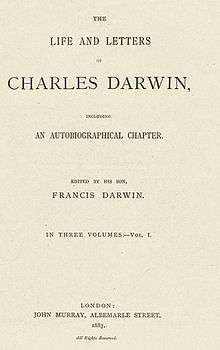Correspondence of Charles Darwin

The British naturalist Charles Darwin corresponded with numerous other luminaries of his age and members of his family. These have provided many insights about the nineteenth century, from scientific exploration and travel to religious debate and discussion. The letters also illuminate many aspects of Darwin's work: the development of his scientific ideas; his opinions on issues he did not publish about (his letters to Asa Gray, for example, show his changing opinions on the American Civil War); matters about his character and health; the ways in which he relied upon correspondence for much of his investigations into natural history; and the ways in which he marshalled scientific support for his ideas amongst friends and colleagues. The historian of science Janet Browne has argued in her biography of Darwin that his ability to correspond daily played a crucial role in the development of his theory and his ability to garner support for it from colleagues.
Analysis and publication of Darwin's correspondence has been a main focus of the so-called Darwin Industry of historical scholarship.
History
Correspondence was central to Darwin's research. In his early years, most of the letters he filed away immediately were those relevant to one of his ongoing scientific projects. Other letters were stuck onto "spits", as he called them, and when his slender stock of these was exhausted, he would burn the letters of several years, in order that he might make use of the liberated "spits." This process, carried on for years, destroyed many of the letters received before 1862. Even so, the number of letters is remarkable, even in these early years. After publication of the Origin of Species, Darwin's children convinced him to save a far greater proportion of his correspondence, so that the sequence from the early 1860s onwards is remarkably full.

In 1887, five years after Darwin's death, Darwin's son Francis Darwin published The Life and Letters of Charles Darwin in three volumes, to accompany the publication of The Autobiography of Charles Darwin. This was later followed by two volumes of More Letters of Charles Darwin published in 1902.
In 1974 the Darwin Correspondence Project was founded at Cambridge University by Frederick Burkhardt, with the aid of Sydney Smith. Cambridge University owns 9,000 letters and has obtained copies of another 6,000 held in private collections. New letters are being discovered at around 60 per year and photocopies of new finds should be sent to the project, which will eventually publish them. Volumes of the correspondence appear at regular intervals from Cambridge University Press, with the content freely available online after four years. The Darwin Correspondence website also includes extensive additional materials, including resources for using the letters in school and university teaching.
List of notable persons with whom Darwin corresponded
Entries marked with asterisks denote persons for which 100 letters or more have been located. All of these letters can be found on the Darwin Correspondence Project website.
References
- Browne, Janet, Charles Darwin: Voyaging. Princeton, 1995.
- Browne, Janet, Charles Darwin: The Power of Place. Princeton, 2002.
Darwin Correspondence Project website
- Darwin Correspondence Project Home Page, University Library, Cambridge. (Accessed 2009-05-07)
Darwin Correspondence Project publications
- Volume 1: 1821–1836 (pub 1985) ISBN 0-521-25587-2
- Volume 2: 1837–1843 (pub 1986) ISBN 0-521-25588-0
- Volume 3: 1844–1846 (pub 1987) ISBN 0-521-25589-9
- Volume 4: 1847–1850 (pub 1988) ISBN 0-521-25590-2
- Volume 5: 1851–1855 (pub 1989) ISBN 0-521-25591-0
- Volume 6: 1856–1857 (pub 1990) ISBN 0-521-25586-4
- Volume 7: 1858–1859 (pub 1991) ISBN 0-521-38564-4
- Volume 8: 1860 (pub 1993) ISBN 0-521-44241-9
- Volume 9: 1861 (pub 1994) ISBN 0-521-45156-6
- Volume 10: 1862 (pub 1997) ISBN 0-521-59032-9
- Volume 11: 1863 (pub 1999) ISBN 0-521-59033-7
- Volume 12: 1864 (pub 2001) ISBN 0-521-59034-5
- Volume 13: 1865 (pub 2003) ISBN 0-521-82413-3
- Volume 14: 1866 (pub 2004) ISBN 0-521-84459-2
- Volume 15: 1867 (pub 2005) ISBN 0-521-85931-X
- Volume 16 pt i: 1868 (pub 2008) ISBN 978-0-521-88195-1
- Volume 16 pt ii: 1868 (pub 2008) ISBN 978-0-521-88196-8
- Volume 17: 1869 (pub 2009) ISBN 978-0-521-19030-5
- Volume 18: 1870 and supplement (pub 2010) ISBN 978-0-521-76889-4
- Volume 19: 1871 (pub 2012) ISBN 978-1-107-01648-4
- Volume 20: 1872 (pub 2013) ISBN 978-1-107-03844-8
- Volume 21: 1873 (pub 2014) ISBN 978-1-107-05214-7
- Volume 22: 1874 (pub 2015) ISBN 978-1-107-08872-6
- Volume 23: 1875 (pub 2015) ISBN 978-1-107-13436-2
- Volume 24: 1876 (pub 2016) ISBN 978-1-107-18057-4
- Further volumes are anticipated (to about 30 volumes in total)
Selections of letters published by the Correspondence Project include:
- Origins: Charles Darwin's Selected Letters, 1825–1859 ISBN 978-0-521-89862-1
- Evolution: Charles Darwin's Selected Letters, 1860–1870 ISBN 978-0-521-87412-0
- Charles Darwin: The Beagle Letters ISBN 978-0-521-89838-6 (all the letters to and from Darwin during the voyage)
- The correspondence 1821-60: anniversary paperback set ISBN 978-0-521-12154-5
- Darwin and women: a selection of letters ISBN 978-1-107-15886-3
Early editions of Darwin's letters
- More Letters of Charles Darwin vol 2 at Project Gutenberg
- Letters on Geology The Complete Work of Charles Darwin Online
- Life and Letters and Autobiography The Complete Work of Charles Darwin Online
- More Letters The Complete Work of Charles Darwin Online
- Letter on Vivisection The Complete Work of Charles Darwin Online
- Charles Darwin Letters Two collections of letters written to and by Charles Darwin